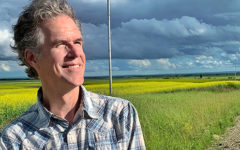 Legitimate old-timers and serious students of bluegrass music recognize Bill Monroe as a bona fide rebel.
Legitimate old-timers and serious students of bluegrass music recognize Bill Monroe as a bona fide rebel.
When he first burst onto the music scene in the 1940s, he was both a visionary and a revolutionary. Using the mandolin as a lead instrument, primarily in closed positions, and church-style, 3 and 4 part harmony were new sounds in country/hillbilly music even before Earl Scruggs turned it all upside down with his banjo picking.
Many current bluegrass fans look to Monroe as the keeper of the tradition, perhaps without considering that he had made a serious break with existing mountain music conventions himself. Of course, Big Mon did insist that his music be played strictly according to his wishes while he was alive, and was known to have dismissed the emergence of newgrass in the 1970s saying “that ain’t no part of nothing.”
Each successive generation of grassers has pushed the boundaries a bit, with the establishment pushing back. The venerable Bluegrass Unlimited panned The Country Gentlemen when they first hit early in their career, and blasted the classic Rounder 0044 album from JD Crowe and the New South in a review in 1975.
All other things being equal, I typically find the ongoing “What is bluegrass” argument to be tedious and uninteresting in the extreme. But my eyes perked up when Chris Pandolfi, banjoist extraordinaire with The Infamous Stringdusters, posted a manifesto of sorts on April 21 where he discussed the question from the standpoint of branding.
His piece began by noting that when the ‘Dusters got started in 2005, there wasn’t any question about how they would promote themselves. All six of them were bluegrass musicians who had been working in bluegrass bands. Sure, some of the music they had performed leaned left, but their self-perception was as a bluegrass band.
But then things changed…
The next few years flew by. We were consumed with the task of staying afloat and keeping our band together (the biggest challenge for any young group). We worked hard on our music, assuming that it would reach the fans who would enjoy it most. But it’s not that easy. In 2009 we started to more closely examine the trajectory of our career. A few shows with Railroad Earth gave us a glimpse into a world that most of us had at one time been a part of as fans, but our band had lost touch with. Something clicked, and everything changed.
With the help of our management, the Artist Farm, we started to think much more deeply about what we wanted. The most obvious questions (how many shows a year? what types of venues?) led to more significant ones (what type of experience do we want to create? what types of people do we want to play for? what types of people are we?), ultimately helping us truly understand what’s best for us as people and as a business. It was a major revelation. Somehow all the hard work of getting a band going distracted us from these important issues (not uncommon). But suddenly we knew much more clearly what we wanted. Big changes to our branding/marketing efforts were imminent, which meant we had to revisit that crucial initial question: what kind of music do you play?
Should we call ourselves a bluegrass band? It just wasn’t so obvious anymore. Newly empowered with a vision of bigger shows, standing clubs and huge sound/lights, we were ready to put our music in a setting where it would come to life. This ideal gig setting would surely bring out the best in us, attracting the right fans, the fans we are after, and the scene would grow. It was obvious that we needed to project something new in our marketing message to the world. We needed to build it. But this was a significant departure from the scene we’d been a part of, and there were real concerns about alienating existing fans. These great new gigs would not be so great if they didn’t make us any money and the band broke up. As we got to know our new fans (this is key) we learned that if we were to create a big party show, it had to be that show every time. At big shows, fans are there to see you but also to be part of the scene. A fan who expects to drink beers and talk to their friends will not be happy if they have to sit in silence at a PAC. That fan might never come to see you again, or they might tell 20 friends if they see you in the right setting/scene.The transition would have to be very deliberate, definitely a leap of faith. Some fans would make the switch with us, and some would not, but that process of natural selection turned out to be a healthy one. We want people who want to be in that setting with us. They are music lovers, and they are a key component to success when they get involved in the shows and get behind the band. So how do we get the ball rolling with these fans and get to this bigger scene that we’ve decided we want to be a part of?
You can read the entire piece at chrispandolfi.com, or at Encore online. In fact, if you haven’t already done so, shoot over there and read it, and then rush right back.
Chris’ post set off something of a firestorm, reigniting the whole ‘What is bluegrass, anyway’ debate. Fans of more progressive acoustic string music had his back, filling his comments with ‘atta boys. Some more mainstream fans objected to seeing their beloved bluegrass described as a ‘brand,’ and even resented the notion that the ‘Dusters had ‘moved beyond’ bluegrass to something better.
For his part, Chris was just trying to express how his band had dealt with a change in their perspective, and the questions that arose about what they should call themselves.
After several weeks of online discussions about his comments, Chris agreed to share his current thoughts with the readers of Bluegrass Today.
First of all thanks to everyone for reading. The response has been very positive. A push for openness is not new to the bluegrass world, but the circumstances surrounding the music and the industry in 2011 are totally unique. It’s impossible to predict what might change, but I definitely think that ‘bluegrass’ is primed to grow and flourish, without sacrificing any of the things that traditionalists seem to be concerned about.
A few aspects of my piece were misunderstood. When I say that deciding what type of music you play is a ‘business decision,’ I am referring only to the name that you give your music for marketing purposes, not the music itself. Implicit in this whole discussion of marketing/business is the idea that our music is our art, our expression of ourselves. This is one of the hallmarks of acoustic music: it’s music with integrity, music with a rich history, it’s QUALITY music. When you start a band/business you need a well conceived image that’s meaningful to you, that connects you to the fans who understand and contribute to the musical experience. Your branding is derived from your art, and not the other way around. I am not saying that people should change their music. I am saying that this is the time for quality music to rise up.
In reference to the age-old struggle to define the genre I mention that bluegrass is ‘whatever someone says it is.’ I think this was also misunderstood. I am not suggesting that we drop all prior notions of what bluegrass is. The difference between Blue Highway and Mumford is still clear as day. But music is not a world of absolutes, it’s a world of creativity and expression, of evolution. Every artist is a product of their influences, and very often the resulting sound is made of many parts. To think that music does or does not belong to a given genre is missing the point. A song can be part ‘bluegrass’ and part something else–as many parts as you want. We can all point out some definite examples of bluegrass proper (Kentucky Thunder, JD Crowe, Dan Paisley), but the grey area of ‘part bluegrass’ bands is huge and growing.
I definitely got a lot of warnings and advice. While I love a good piece of advice, please don’t worry about the Stringdusters. We are happier and more cohesive than ever before – loving life in every way. Come see the new show if you want to see what this is all about.
There’s one thing I cannot say enough times: the music we all love does not have to change. The music that’s happening at this moment in time happens regardless of what people call it. Any given scene will continue to exist, from the most traditional to the most progressive. There’s nothing to worry about! Great musicians will continue to find each other and make great music. With groundbreaking bands like the Punch Brothers already on the scene, there’s no telling where acoustic music will go next, but it is surely in competent hands.
The question is what will happen to the term ‘bluegrass’ (still very much a non-mainstream sub-genre) and its trade association, the IBMA? Maybe nothing, and maybe that’s OK. But right now it certainly looks little open-mindedness could really go a long way.
I’ve known Chris for many years, and have always found his playing, and his personality, reflective of a quick and agile mind. As a commenter suggested on his site, Pandolfi is the thinking man’s banjo player.
And so the saga continues…







